This set of Network Theory Multiple Choice Questions & Answers (MCQs) focuses on “Advanced Problems on Two Port Network – 1”.
1. For the circuit given below, the value of the z12 parameter is ___________
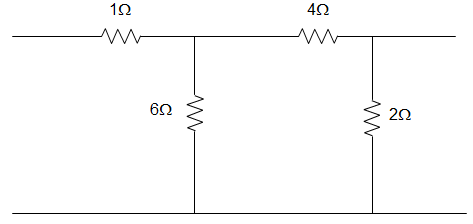
a) z12 = 1 Ω
b) z12 = 4 Ω
c) z12 = 1.667 Ω
d) z12 = 2.33 Ω
View Answer
Explanation: z11 = \(\frac{V_1}{I_1}\) = 1 + 6 || (4+2) = 4Ω
I0 = \(\frac{1}{2} I_1 \)
V2 = 2I0 = I1
z21 = \(\frac{V_2}{I_1}\) = 1Ω
z22 = \(\frac{V_2}{I_2}\) = 2 || (4+6) = 1.667Ω
So, I’0 = \(\frac{2}{2+10}I_2 = \frac{1}{6}I_2 \)
V1 = 6I’0 = I2
z12 = \(\frac{V_1}{I_2}\) = 1Ω
Hence, [z] = [4:1; 1:1.667] Ω.
2. For the network of figure, z11 is equal to ___________
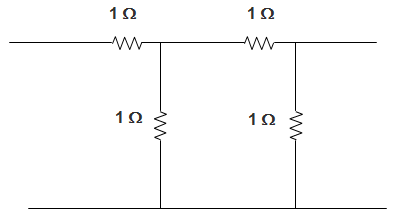
a) \(\frac{5}{3}\) Ω
b) \(\frac{3}{2}\) Ω
c) 2 Ω
d) \(\frac{2}{3}\) Ω
View Answer
Explanation: From the figure, we can infer that,
Z11 = 1 + \(\frac{1 X 2}{3}\)
= 1 + \(\frac{2}{3}\)
= \(\frac{5}{3}\) Ω.
3. For the circuit given below, the value of z11 parameter is ____________
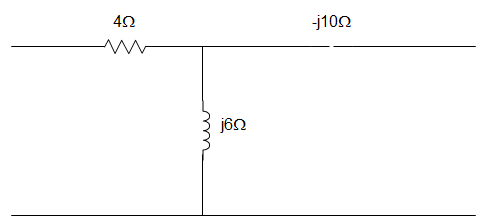
a) z11 = 4 + j6 Ω
b) z11 = j6 Ω
c) z11 = -j6 Ω
d) z11 = -j6 + 4 Ω
View Answer
Explanation: z12 = j6 = z21
z11 – z12 = 4
Or, z11 = z12 + 4 = 4 + j6 Ω
And z22 – z12 = -j10
Or, z22 = z12 + -j10 = -j4 Ω
∴ [z] = [4+j6:j6; j6:-j4] Ω.
4. In a series RLC circuit excited by a voltage 3e-t u (t), the resistance is equal to 1 Ω and capacitance = 2 F. For the circuit, the values of I (0+) and I (∞), are ____________
a) 0 and 1.5 A
b) 1.5 A and 3 A
c) 3 A and 0
d) 3 A and 1.5 A
View Answer
Explanation: I(s) = \(\frac{6}{s+1} – \frac{3}{s+0.5}\)
Or, I(t) = 6 e-t – 3 e-0.5t
Putting, t = 0, we get, I(0) = 3A
Putting t = ∞, we get, I (∞) = 0.
5. For the circuit given below, the value of z12 parameter is ____________
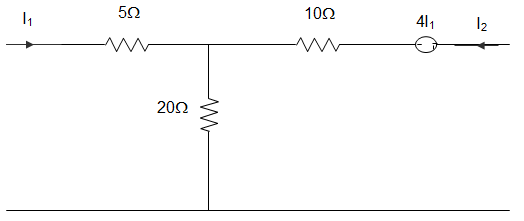
a) Z12 = 20 Ω
b) Z12 = 25 Ω
c) Z12 = 30 Ω
d) z12 = 24 Ω
View Answer
Explanation: z11 = \(\frac{V_1}{I_1} = \frac{(20+5)I_1}{I_1}\) = 25Ω
V0 = \(\frac{20}{25}\)V1 = 20 I1
-V0 – 4I2 + V2 = 0
Or, V2 = V0 + 4I1 = 20I1 + 4I1 = 24 I1
Or, z21 = \(\frac{V_2}{I_1}\) = 24 Ω
V2 = (10+20) I2 = 30 I2
Or, z22 = \(\frac{V_2}{I_1}\) = 30 Ω
V1 = 20I2
Or, z12 = \(\frac{V_1}{I_2}\) = 20 Ω
∴ [z] = [25:20; 24:30] Ω.
6. For the circuit given below, the value of the z22 parameter is ___________

a) z22 = 1 Ω
b) z22 = 4 Ω
c) z22 = 1.667 Ω
d) z22 = 2.33 Ω
View Answer
Explanation: z11 = \(\frac{V_1}{I_1}\) = 1 + 6 || (4+2) = 4Ω
I0 = \(\frac{1}{2} I_1 \)
V2 = 2I0 = I1
z21 = \(\frac{V_2}{I_1}\) = 1Ω
z22 = \(\frac{V_2}{I_2}\) = 2 || (4+6) = 1.667Ω
So, I’0 = \(\frac{2}{2+10}I_2 = \frac{1}{6}I_2 \)
V1 = 6I’0 = I2
z12 = \(\frac{V_1}{I_2}\) = 1Ω
Hence, [z] = [4:1; 1:1.667] Ω.
7. For the circuit given below, the value of z22 parameter is ____________
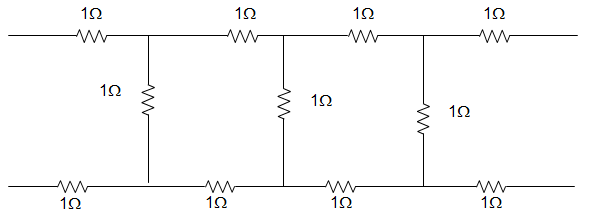
a) z22 = 0.0667 Ω
b) z22 = 2.773 Ω
c) z22 = 1.667 Ω
d) z22 = 0.999 Ω
View Answer
Explanation: z11 = \(\frac{V_1}{I_1}\) = 2 + 1 || [2+1 || (2+1)]
z11 = 2 + 1 || (2 + \(\frac{3}{4}\)) = 2 + \(\frac{1×\frac{11}{4}}{1+\frac{11}{4}} = 2 + \frac{11}{15}\) = 2.733
I0 = \(\frac{1}{1+3}\) I’0 = \(\frac{1}{4}\) I’0
And I’0 = 1 + \(\frac{11}{4}\) I1 = \(\frac{4}{15}\) I1
Or, I0 = \(\frac{1}{4} × \frac{4}{5} I_1 = \frac{1}{15} I_1\)
Or, V2 = I0 = \(\frac{1}{15} I_1\)
z21 = \(\frac{V_2}{I_1} = \frac{1}{15}\) = z12 = 0.0667
z22 = \(\frac{V_2}{I_2}\) = 2+1 || (2+1||3) = z11 = 2.733
∴ [z] = [2.733:0.0667; 0.0667:2.733] Ω.
8. For the circuit given below, the value of z22 parameter is ____________

a) z22 = 4 + j6 Ω
b) z22 = j6 Ω
c) z22 = -j4 Ω
d) z22 = -j6 + 4 Ω
View Answer
Explanation: z12 = j6 = z21
z11 – z12 = 4
Or, z11 = z12 + 4 = 4 + j6 Ω
And z22 – z12 = -j10
Or, z22 = z12 + -j10 = -j4 Ω
∴ [z] = [4+j6:j6; j6:-j4] Ω.
9. For the circuit given below, the value of z22 parameter is ____________
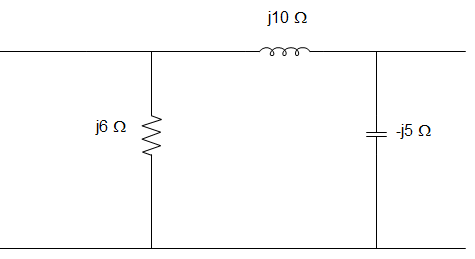
a) z22 = 1.775 + j5.739 Ω
b) z22 = 1.775 – j4.26 Ω
c) z22 = -1.775 – j5.739 Ω
d) z22 = 1.775 + j4.26 Ω
View Answer
Explanation: z1 = \(\frac{12(j10)}{12+j10-j5} = \frac{j120}{12+j5}\)
z2 = \(\frac{j60}{12+j5}\)
z3 = \(\frac{50}{12+j5}\)
z12 = z21 = z2 = \(\frac{(-j60)(12-j5)}{144+25}\) = -1.775 – j4.26
z11 = z1 + z12 = \(\frac{(j120)(12-j5)}{144+25}\) + z12 = 1.775 + j4.26
z22 = z3 + z21 = \(\frac{(50)(12-j5)}{144+25}\) + z21 = 1.7758 – j5.739
∴ [z] = [1.775 + j4.26; -1.775 – j4.26; -1.775 – j4.26; 1.775 – j5.739] Ω.
10. For the circuit given below, the value of z22 parameter is ____________

a) z22 = 20 Ω
b) z22 = 25 Ω
c) z22 = 30 Ω
d) z22 = 24 Ω
View Answer
Explanation: z11 = \(\frac{V_1}{I_1} = \frac{(20+5)I_1}{I_1}\) = 25Ω
V0 = \(\frac{20}{25}\)V1 = 20 I1
-V0 – 4I2 + V2 = 0
Or, V2 = V0 + 4I1 = 20I1 + 4I1 = 24 I1
Or, z21 = \(\frac{V_2}{I_1}\) = 24 Ω
V2 = (10+20) I2 = 30 I2
Or, z22 = \(\frac{V_2}{I_1}\) = 30 Ω
V1 = 20I2
Or, z12 = \(\frac{V_1}{I_2}\) = 20 Ω
∴ [z] = [25:20; 24:30] Ω.
11. A capacitor of 220 V, 50 Hz is needed for AC supply. The peak voltage rating of the capacitor is ____________
a) 220 V
b) 460 V
c) 440 V
d) 230 V
View Answer
Explanation: We know that,
Peak voltage rating = 2 (rms voltage rating)
Given that the RMS voltage rating = 220 V
So, the Peak Voltage Rating = 2 X 220 V
= 440 V.
12. In the circuit given below, the value of the hybrid parameter h21 is _________
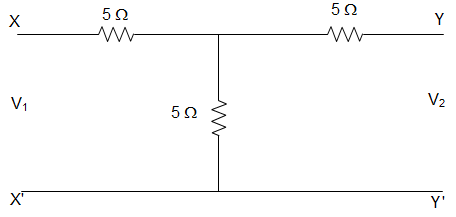
a) 10 Ω
b) 0.5 Ω
c) 5 Ω
d) 2.5 Ω
View Answer
Explanation: Hybrid parameter h21 is given by, h21 = \(\frac{I_2}{I_1}\), when V2 = 0.
Therefore short circuiting the terminal Y-Y’, and applying Kirchhoff’s law, we get,
-5 I2 – (I2 – I1)5 = 0
Or, -I2 = I2 – I1
Or, -2I2 = -I1
∴ \(\frac{I_2}{I_1} = \frac{1}{2}\)
Hence h21 = 0.5 Ω.
13. If a two port network is passive, then we have, with the usual notation, the relationship as _________
a) h21 = h12
b) h12 = -h21
c) h11 = h22
d) h11 h22 – h12 h22 = 1
View Answer
Explanation: We know that, I1 = y11 V1 + y12 V2 ……… (1)
I2 = y21 V1 + y22 V2 ………. (2)
And, V1 = h11 I1 + h12 V2 ………. (3)
I2 = h21 I1 + h22 V2 ……….. (4)
Now, (3) and (4) can be rewritten as,
I1 = \(\frac{V_1}{h_{11}} – \frac{h_{12} V_2}{h_{11}}\) ………. (5)
And I2 = \(\frac{h_21 V_1}{h_11} + \left(- \frac{h_{21} h_{12}}{h_{11}} + h_{22}\right) V_2\) ………. (6)
Therefore using the above 6 equations in representing the hybrid parameters in terms of the Y parameters and applying ∆Y = 0, we get,
h11 h22 – h12 h22 = 1 [hence proved].
14. In two-port networks the parameter h22 is called _________
a) Short circuit input impedance
b) Short circuit current gain
c) Open circuit reverse voltage gain
d) Open circuit output admittance
View Answer
Explanation: We know that, h22 = \(\frac{I_2}{V_2}\), when I1 = 0.
Since the current in the first loop is 0 when the ratio of the current and voltage in second loop is measured, therefore the parameter h12 is called as Open circuit output admittance.
15. The short-circuit admittance matrix of a two port network is as follows.
[0; -0.5; 0.5; 0]
Then the 2 port network is ____________
a) Non-reciprocal and passive
b) Non-reciprocal and active
c) Reciprocal and passive
d) Reciprocal and active
View Answer
Explanation: So, network is non reciprocal because Y12 ≠ Y21 and Y12 are also negative which means either energy storing or providing device is available. So the network is active.
Therefore the network is Non- reciprocal and active.
Sanfoundry Global Education & Learning Series – Network Theory.
To practice all areas of Network Theory, here is complete set of 1000+ Multiple Choice Questions and Answers.
If you find a mistake in question / option / answer, kindly take a screenshot and email to [email protected]
- Check Electronics & Communication Engineering Books
- Apply for Electronics & Communication Engineering Internship
- Practice Electrical Engineering MCQs
- Apply for Electrical Engineering Internship
- Check Network Theory Books
